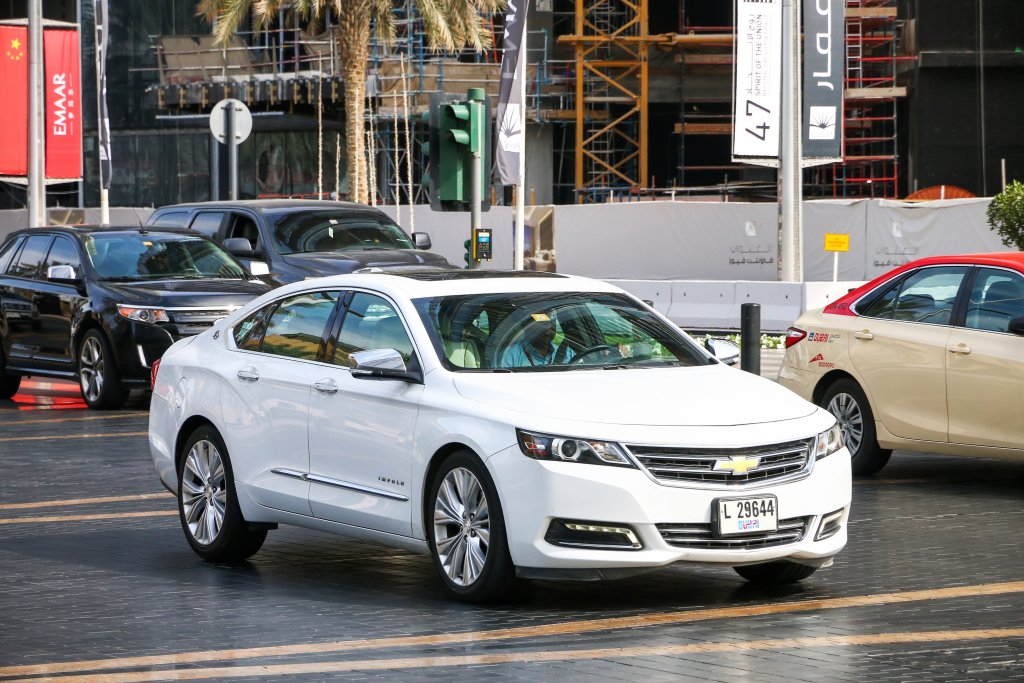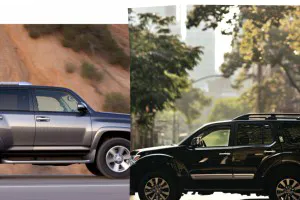The Impala is a storied name in American motoring. From 1958 to 2020, the nameplate anchored Chevy’s passenger car lineup. And in its heyday, the Impala set all-time sales records. In 1965 and 1966, Chevrolet sold more than one million Impalas, a feat no other manufacturer has achieved.
Chevrolet discontinued the Impala after 2020, but it lives on in the second-hand market. In fact, sedans like this Chevy can be smart buys because used car shoppers want SUVs and pickups. However, the key to success with this approach is selecting the right Chevy Impala model year. This is crucial because the bad Impala model years outnumber the good Impala model years.
To separate the best and worst years of the Chevy Impala, we looked at data to pinpoint model year reliability. Specifically, this includes reports from Chevy Impalas with an installed FIXD sensor. This data is used to create the FIXD Reliability Score. We also surveyed many owners to create the Owner Reliability Score. Owners provided feedback on repair costs, problem areas, and reliability perceptions.
The next step involves combining the FIXD Reliability and Owner Reliability Scores with published information about vehicle safety, fuel economy, and resale values to identify the best and worst Impala model years. The results can help a shopper avoid troublesome Impalas and offer insights for current Impala owners.
Here’s an overview of the results; keep reading to learn the details behind these recommendations.
| Best Years | Why? | Worst Years | Why? |
| 2015-2019 |
Strong engine and owner ratings, solid safety ratings, and low number of recalls |
2014 |
First year of the 10th generation, high number of recalls, and increased risk of expensive engine repairs. |
| 2009-2010, 2012-2013 |
High owner reliability scores, low chance of costly engine repairs |
2006-2008, 2011 |
First year of the 10th generation (2006), mediocre engine reliability scores, and higher chance for expensive repairs |
| 2001-2005 |
Low engine reliability scores, extremely high chance of engine repairs. |
Chevrolet Impala Engine Reliability Score, Safety Ratings & MPG Year by Year
The best and worst Chevy Impala model years come from looking at:
- FIXD Reliability Score (engine reliability)
- Owner Reliability Score (overall reliability based on owner surveys)
- NHTSA safety ratings
- Fuel economy (EPA estimates)
- Annual costs for maintenance and repairs as they relate to market value (from owner surveys and KBB data).
The elements are detailed below.
If you’re in the market for a car, look at our article on the USA’s most reliable and cheapest to repair vehicles. Don’t get stuck with a lemon; use our data to help you shop.
Engine Reliability Score – Over The Years
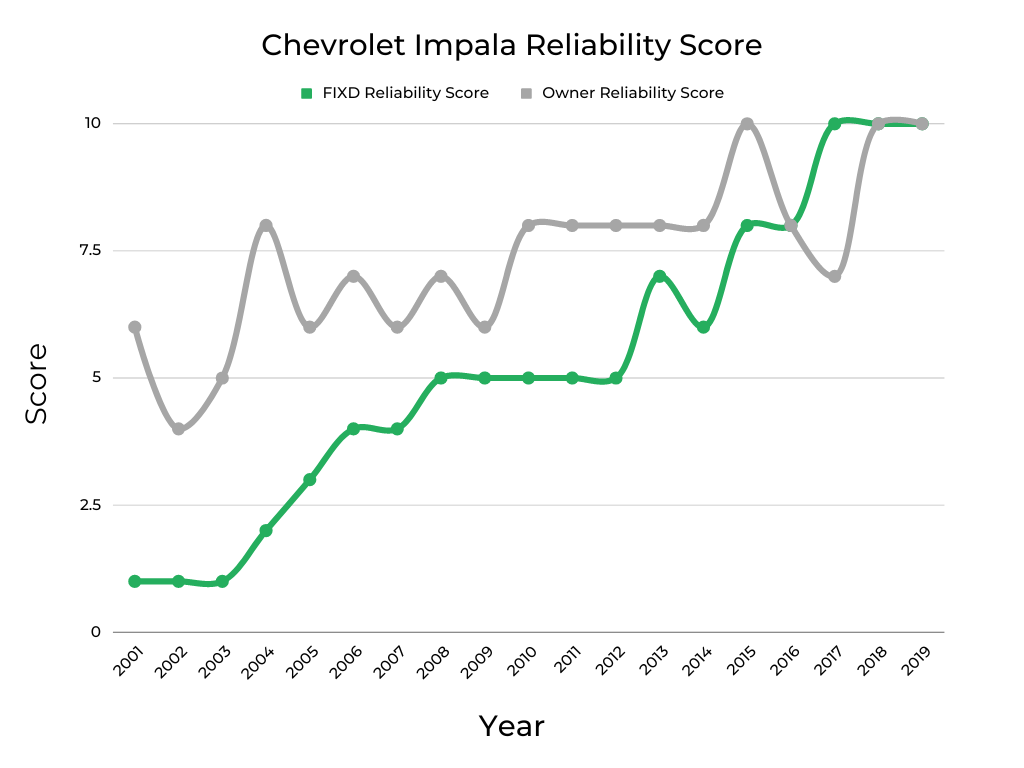
The graph illustrates two benchmarks for Chevy Impala engine reliability.
- FIXD Reliability Score (green): Determined by the frequency of check engine lights recorded in Impalas with a FIXD sensor.
- Owner Reliability Score (gray): The perceived reliability of Impalas based on surveys, with responding owners indicating how likely their cars can handle trips of different lengths. Short point A to point B travel, for instance, receives the lowest rating. However, a vehicle suitable for cross-country road trips, ranks highest.
The FIXD Reliability Score and the Owner Reliability Score are based on a 1 (lowest) to 10 (highest) scale; 5 is average.
The reliability chart shows a gap between the two scores. These results are nothing unusual as owners often accept that an older car comes with more check engine lights. But clearly, you can see how the hard data (documented check engine light incidents) stack up against opinions (owner reliability perceptions).
A low rating for either of these scores doesn’t automatically mean a particular Impala model year gets a thumbs down. On the other hand, low rankings for both benchmarks almost always assign an Impala model year to the worst list. A case in point is the 2002 Impala, which has a FIXD Reliability Score of 1 and an Owner Reliability Score of 3 (the lowest of any Impala). This is a Chevy Impala to avoid at all costs.
Conversely, high scores in both measures frequently signal an Impala worth buying. For example, the 2015 Impala gets a respectable FIXD Reliability Score of 8 and a perfect Owner Reliability Score of 10.
But these scores aren’t the sole determiners of a passing or a failed grade for the Chevy Impala. As mentioned, we also add safety data, recalls, and repair frequency to the mix.
Read the Chevrolet Check Engine Light article to discover the most common causes for a check engine light in an Impala and other Chevys.
NHTSA Safety Score – Over The Years
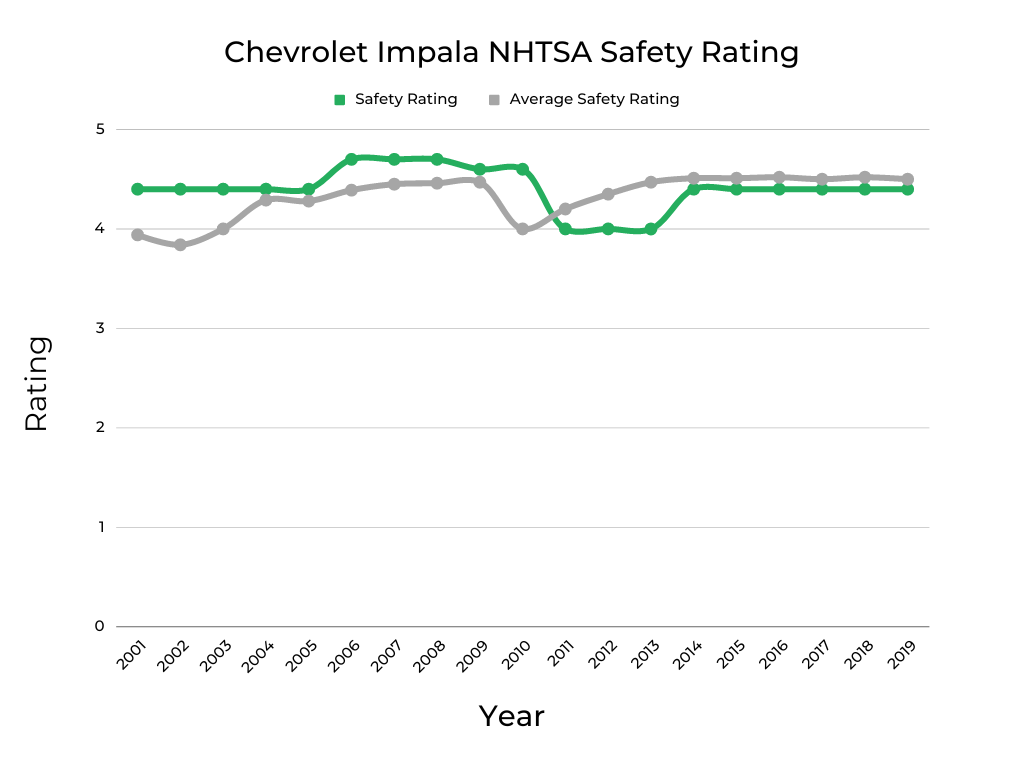
Safety is paramount for most vehicle owners, but more so for those with a Chevy Impala. Half of all surveyed Impala owners use their Chevys for family transportation. And another 32% rely on their cars for “lots of driving,” like traveling and commuting. Testing from the National Highway Transportation Safety Administration (NHTSA) measures how the Impala performs during crash and rollover simulations.
Every modern Impala scores at least a 4.0 (out of 5) in NHTSA testing (the green line), which is particularly impressive for the older models. There was a slight dip in test performance from 2011-2013 following more stringent government safety requirements, but this got addressed with the launch of the tenth-generation Impala for the 2014 model year.
Otherwise, the Impala is a solid performer in NHTSA testing and is competitive against other vehicles we have safety data on (gray line).
Strong safety scores help protect vehicle occupants and keep insurance costs low.
Keeping a focus on solid safety scores helps If you live in one of the states listed below, we can show you the cheapest vehicles to insure in yours.
What Used Cars Are the Cheapest To Insure In:
| What Used Cars Are the Cheapest To Insure In: |
| Ohio |
| North Carolina |
| Michigan |
| Georgia |
| Texas |
| New York |
| Illinois |
| Pennsylvania |
| California |
MPG – Over The Years
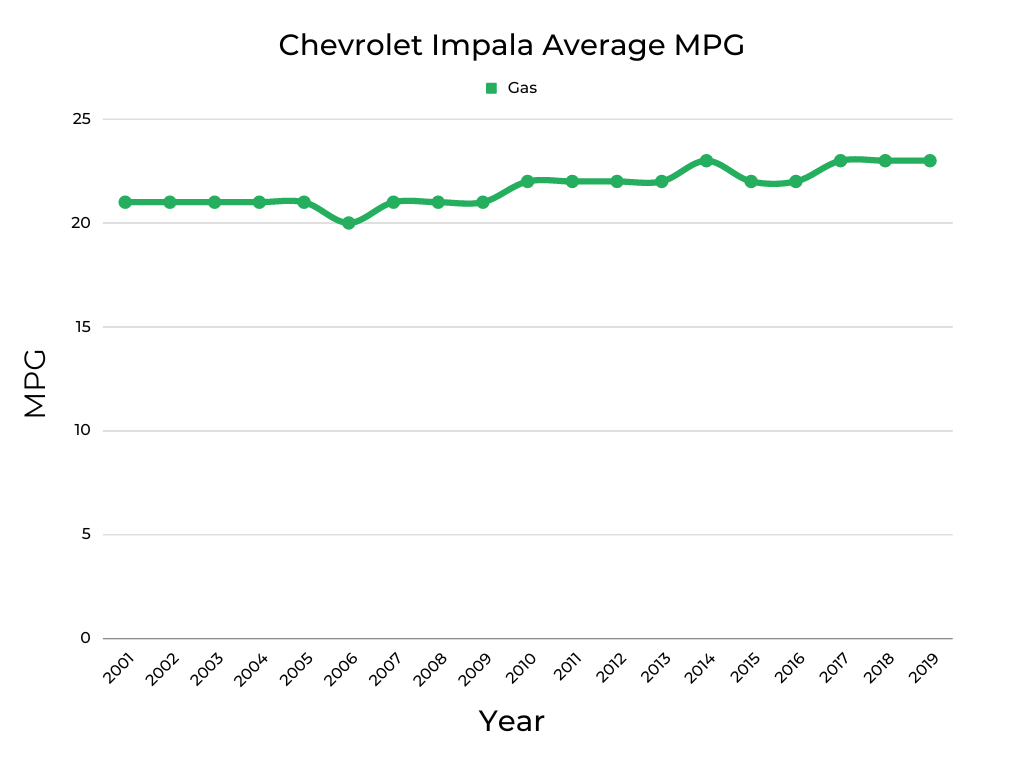
A fuel economy rating of 20 MPG (or slightly better) may not sound great, but the Impala is a large sedan. And compared to older models, the 21st-century Impala is a fuel sipper.
This performance at the pump comes from mostly six-cylinders under the hood, although some eighth- and ninth-generation Impalas did have V8 engines. Chevy even experimented with a four-cylinder mild hybrid setup for a few years, but this engine got dropped due to low sales.
The chart reflects an average for each Impala model year based on EPA results. If you need significantly better fuel economy than 20 MPG, you might want to shop for a different vehicle (although fuel economy on the highway is usually much better). But don’t assume other large sedans use less gas. The Impala sits squarely in the middle of the Ford Taurus and Toyota Avalon.
| Chevrolet Impala | Ford Taurus | Toyota Avalon | |
| 2002 | 21 MPG | 20 MPG | 22 MPG |
| 2010 | 22 MPG | 21 MPG | 23 MPG |
| 2018 | 23 MPG | 20 MPG | 24 MPG |
Current Market Value of All Chevrolet Impala Years & Cost Per Year to Repair and Maintain Each
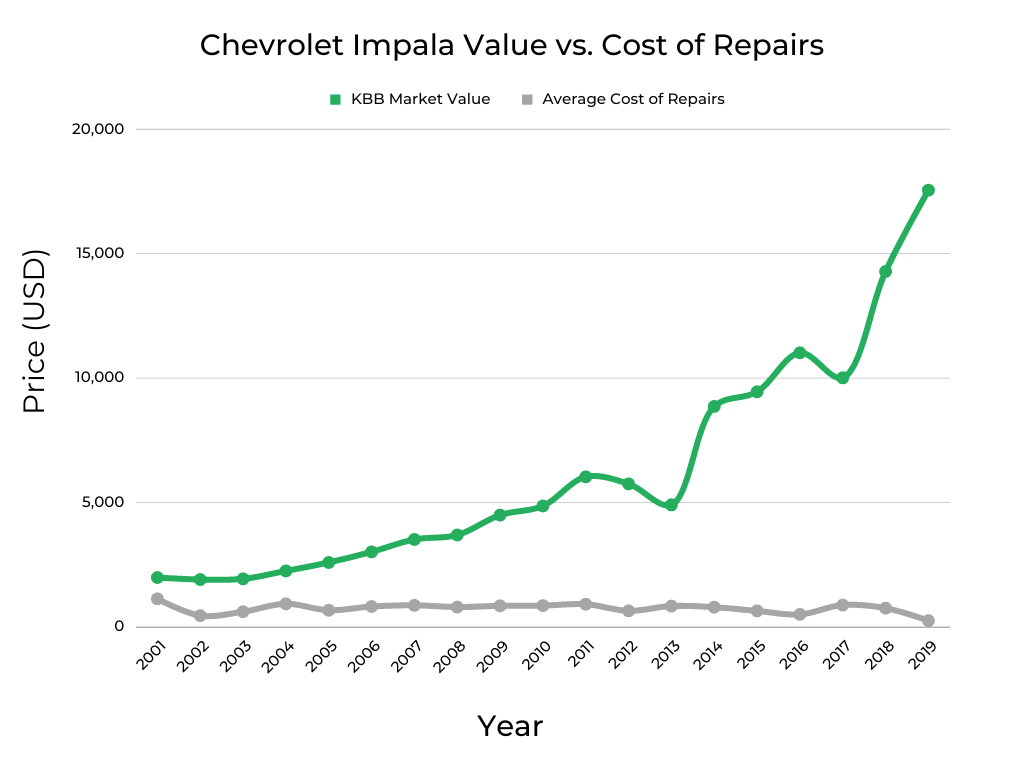
High annual repair and maintenance expenses can negatively affect a car’s resale value. A few Impala models are costly to maintain (2001 at $1,125 and 2004 at $925 yearly). Still, there doesn’t appear to be a connection between elevated upkeep costs and lower resale value for the Impala. For the most part, the continuous increase in the Impala’s market value (green line) confirms this.
However, the Chevy Impala is more expensive to own than the average large sedan. FIXD survey data for the 2001-2018 Impalas show owners spent an average of $771 in 2022 to maintain their cars. This compares to an average of $590 that owners of all full-sized cars spend, according to RepairPal. These extra ownership costs are likely already baked into the KBB resale values.
There are a few instances of Impalas that are cheap to own. Owners of the 2002 and 2016 Impalas report paying only $450 and $500 (respectively) to maintain their cars. These amounts are far below average.
Here’s how the Impala’s yearly upkeep expenses compare by generation.
| Chevrolet Impala Generation | Years | Average Annual Upkeep |
| Eighth | 2001-2005* | $755^ |
| Ninth | 2006-2013 | $819 |
| Tenth | 2014-2018** | $744^ |
^The 2019 Impala is excluded from the average due to limited data.
** 2020 is the final model year for the Chevrolet Impala
While some specific Impala model years are expensive to maintain, there’s surprisingly little difference among the averages for the last three Impala generations. Usually, we see the most- recent generation as less expensive to own.
Some of these newer Impalas (2017-2018) show maintenance and repair expenses above $800, but these likely reflect the cost of replacing the brake pads and tires. Consumables that wear down on every car.
You’ll notice a drop in the market values for the 2013 and 2017 Impala market values. This likely has little to do with annual maintenance and repair expenses. The surveys show these cars have above-average mileage.
If you’d like to learn about this vehicle’s past depreciation rate & our projected depreciation rate based on that, check out: Chevrolet Impala | Depreciation Rate & Curve Graphed.
When shopping for a used Chevy Impala, it’s important to keep in mind that not all vehicles are cared for equally. To protect yourself from lemons, take along a FIXD Sensor on your test drive. FIXD connects to a free app on your smartphone to tell you more about the vehicle you’re checking out, including check engine lights and other hidden issues that the owner or dealership may be attempting to hide. Click here to learn more and get FIXD for only $19.99 (regular price $59)!
Important Features Timeline

1995: Redesigned seats appear; new radio has speed-sensitive volume controls
1996: Last year of the 7th-generation Chevrolet Impala
2000: After a four-year break, the 8th-generation Impala debuts
2001: No major changes
2002: Standard equipment includes dual-zone automatic climate control and AM/FM stereo
2003: Keyless entry standard; options include driver-side airbag and satellite radio
2004: Supercharged Impala SS is added to the lineup
2005: All versions get OnStar as standard equipment
2006: Refreshed interior and exterior; Impala SS gets a V8 engine
2007: No major changes
2008: Satellite radio is standard; lower trims come with a power driver’s seat
2009: ABS and front-seat side airbags are standard on all trims
2010: Impala SS is dropped from the lineup
2011: No major changes
2012: Refreshed exterior; new V6 engine and transmission
2013: Last year of the 9th generation
2014: Redesigned 10th-generation Impala launches
2015: No major changes; 4G data connection/Wi-Fi hotspot standard
2016: Apple CarPlay and wireless device charging become available; 4-cylinder engine droppe
2017: No major changes
2018: Keyless entry and a rearview monitor are standard on all trims
2019: No major changes
2020: Last year of the Chevrolet Impala
Best Years of the Chevrolet Impala
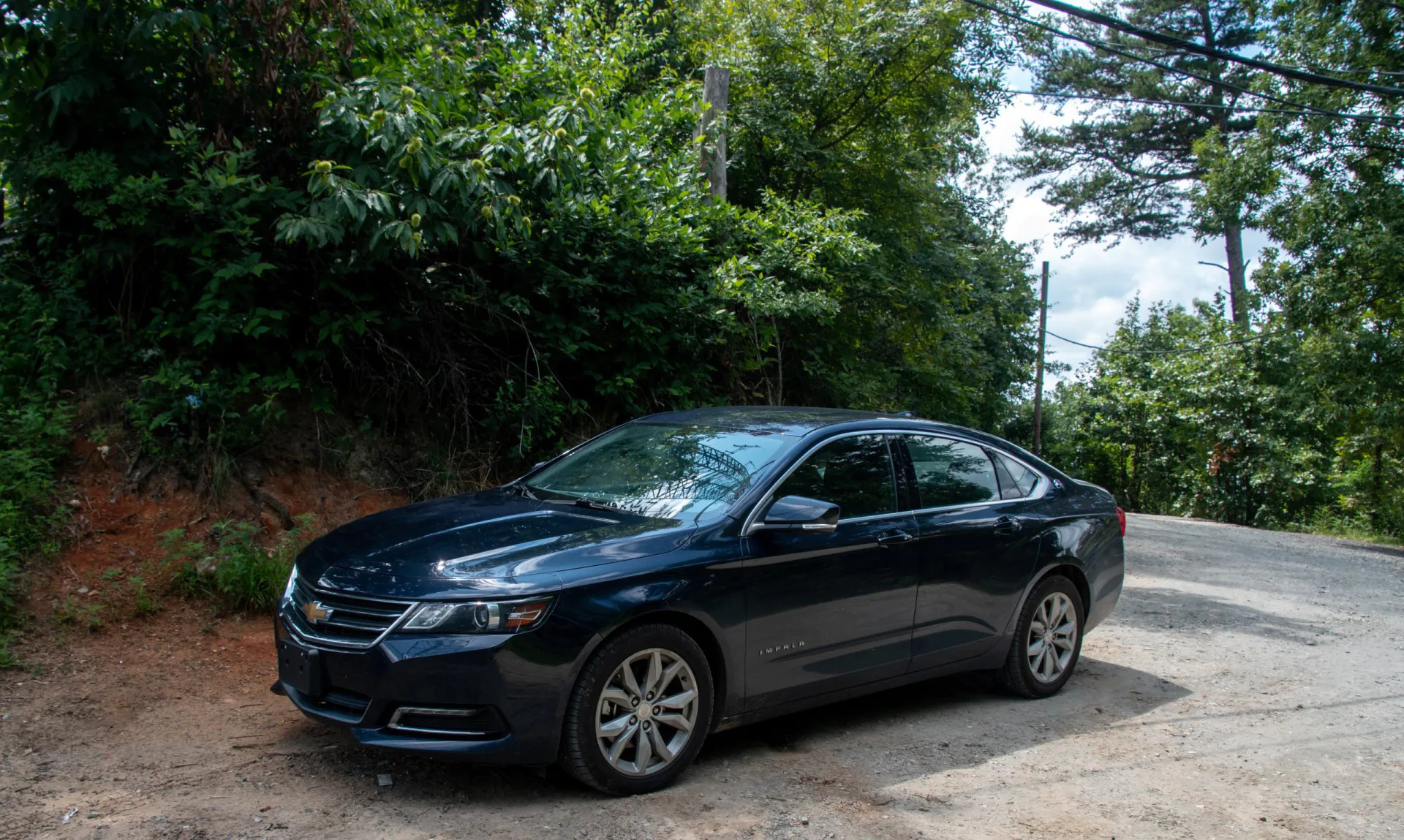
The Chevy Impalas that make this list rank well regarding FIXD Reliability and Owner Reliability Scores, NHTSA safety testing, and fuel economy. We also review common diagnostic trouble codes (DTCs) and NHTSA recall information.
2015-2019 Chevrolet Impala
FIXD Reliability Score: 8-10/10
Owner Reliability Score: 7-10/10
KBB Value: $9,447-$17,552
Fuel Economy: 22-23 MPG
Average Annual Maintenance/Repair: $500-$875
Average Likelihood of a $500+ Repair in 2022: 86%-100%
Safety Rating: 4.4/5
It’s unsurprising that the newest Impala model years take the top spot in our best years list. These sedans enjoy strong FIXD Reliability Scores of at least an 8 (2017-2019 rank an ideal 10) and high Owner Reliability Scores with a 7 for the 2017 edition and an 8 for the 2016 model year. Otherwise, owners give the 2015 and 2018-2019 versions a flawless 10.
One thing’s for sure; these are well-used machines. These Impalas have an average of 100,000 miles of use. Even the 2019 Impala has an average of 75,000 miles. So, seeing these Chevys perform well in reliability rankings is encouraging.
At the same time, an EPA-estimated average fuel economy of 22-23 MPG makes these among the most fuel-efficient Impalas ever sold. And NHTSA safety scores of 4.4 (out of 5) for the 2015-2019 Impala are also laudable.
It’s also worth noting that most models of the 10th-generation Impala have few recalls. The 2015 model year has three recalls, while the 2018 and 2019 editions have only one recall. The six-cylinder 2016 Impala and 2017 Impala had no recalls. However, the 2016 model year with the four-cylinder mild-hybrid engine had nine recalls. In addition, Chevy built the Impala Limited for a few years. It’s a ninth-generation version sold to taxi companies, rental car fleets, and law enforcement agencies. The 2016 Impala Limited had nine recalls.
It’s also important to point out that the 2015-2016 Impalas have below-average annual upkeep expenses ($639 and $500, respectively).
We’ll temper the enthusiasm with a dose of reality, as 12% of 2016 Impala owners and 10% of 2018 Impala owners reported spending at least $500 on engine repairs in 2022. Further, some owners indicated they also had expensive ($500+) transmission repairs last year (7% for the 2015 edition, 9.5% for the 2016 model year, and 13% for the 2018 Impala). These numbers are far better than some older Impalas, which made the worst years list. This data also serves as a reminder that no car is perfect, and every used vehicle should undergo a professional pre-purchase inspection.
Despite the newness of these Impalas, DTC codes do appear, with P0496 being the most likely. This error message signals a malfunctioning purge valve in the evaporative emission control (EVAP) system. Repairs can include replacing the EVAP line ($20-$100) or installing a new volume control valve ($150-$200) or pressure sensor ($280-$330).
Another EVAP-related code, P0442, is also common to the 2015-2019 Impala model years and indicates a leak. Often, the fix just involves tightening the gas cap. However, more elaborate repairs can require a new gas cap ($20-$60), control valve ($150-$200), EVAP line, or charcoal canister ($200-$600).
A faulty mass airflow (MAF) sensor is to blame if code P0171 happens. Sometimes this can be corrected by cleaning the sensor ($20-$100), sealing a vacuum leak ($100-$200), or replacing the sensor ($230-$330).
The KBB values cited above are for private-party transactions. However, dealer-based purchases will be substantially higher. Depending on model year, condition, mileage, and equipment, expect to pay $12,000 to $25,000 for a 2015-2019 Impala (tenth-generation).
Some Impalas may be available through Chevrolet’s certified pre-owned (CPO) program, which adds an extra six months or 6,000 miles of bumper-to-bumper coverage to any existing factory warranty. This protection costs extra, but the additional peace of mind can be worth it.
While all the cars in this grouping are worth checking out, our favorite is the 2017 Impala. According to surveyed owners, despite slightly above-average maintenance and repairs expenses ($875), it has no reports of expensive engine or transmission repairs. With some careful shopping, you can find one for around $15,000 with less than 100,000 miles.
About the 2020 Chevrolet Impala: 2020 marks the last model year for Chevy’s large sedan. However, little available data about reliability and owner experiences make it impossible to pass judgment on the final Impala.
2009-2010, 2012-2013 Chevrolet Impala
FIXD Reliability Score: 5-7/10
Owner Reliability Score: 6-8/10
KBB Value: $4,491-$5,745
Fuel Economy: 21-22 MPG
Average Annual Maintenance/Repair: $643-$854
Average Likelihood of a $500+ Repair in 2022: 86%-100%
Safety Rating: 4.0-4.6/5
Next up on our list of the best years of the Chevy Impala are the 2009-2010 and 2012-2013 model years. The 2011 Impala doesn’t make the cut; see below to learn why it and the ninth-generation Impala’s first three years (2006-2008) are on the worst years list.
Let’s be clear; the 2009-2010 and 2012-2013 Impalas have their faults. But for $5,000 to $12,000, they offer a reasonable transportation option for a buyer needing a large yet somewhat fuel-efficient sedan. A fuel economy rating of 21-22 MPG should help reduce the number of gas station visits, and an overall NHTSA safety rating of 4.0-4.6 (out of 5) is reassuring to everyone inside.
Most Impalas in this group get a mid-range ranking of 5 for the FIXD Reliability Score; however, the 2013 Impala rises to a 7. Ratings for the Owner Reliability Score are predominantly above average, with an 8 for all years except 2009 (which gets a 6). So, we’ll call these passing grades and explore other reasons to give these Chevys a thumbs up.
Mainly, this recommendation comes from a lower chance of costly engine and transmission repairs. Notice we didn’t say, “no chance.” After all, these cars are at least a decade old and have an average of 144,000 miles—a substantial amount of usage. So, some level of significant service work is to be expected. We just prefer vehicles with as low a likelihood as possible.
12% of 2012 Impala owners who reported spending $500 or more said it was to repair the engine in 2022. However, no other owner from this grouping had a similar experience.
It gets slightly worse with the transmission, but nothing approaches the gearbox problems of older Impalas (covered below). Specifically, about 14% of owners with a 2009 or 2010 Impala experienced an expensive transmission repair last year. However, this rate dropped by more than half for those with a 2012-2013 Impala. An average of just 6% of these owners had to pay more than $500 for a transmission repair in 2022.
Annual repair and maintenance expenses of $792 for these Chevys aren’t too far off the overall average of $771 for all modern Impalas. That means ownership costs shouldn’t be absurdly expensive for most owners.
And recalls are modest, too. The 2009 model year is the worst, with five recalls, followed by the 2010 Impala, with four recalls. Recalls drop to three for the 2012 edition, and there’s only one recall for the 2013 Impala.
However, as the FIXD Reliability Score shows, the 2009-2010 and 2012-2013 Chevy Impalas are not free of check engine lights. Based on the FIXD data, the most common error code is P0455, a leak in the EVAP system. Fortunately, remedies are similar to addressing other EVAP problems: tightening or replacing the gas cap, installing a new EVAP line, or getting a new control valve.
P0420 is another common check engine light in these Chevy Impalas; it indicates a faulty oxygen sensor (part of emissions controls). Replacing an oxygen sensor runs $275 to $500, but sometimes the repair requires replacing the catalytic converter, which is expensive ($1,720-$2,400). If the Impala you’re considering hasn’t already received a new catalytic converter (they do wear out due to age or misuse), be sure to have a mechanic pressure test the unit as part of the pre-purchase inspection process. The last thing you want is a repair bill that’s as much as half the car’s value.
Rounding out the top three DTC codes for these Impalas is P0128, a problem with the engine coolant thermostat. A new replacement thermostat costs $477 to $512. This code is a known weakness among several General Motors models.
With proper research and cautious shopping, the 2009-2010 and 2012-2013 Chevy Impala is an excellent option for an affordable, large sedan. We’d suggest stretching the budget to locate a low-mileage 2013 model year if possible. The high FIXD Reliability and Owner Reliability Scores, as are the low instances of expensive powertrain repairs, are appealing.
The Worst Years of the Chevrolet Impala
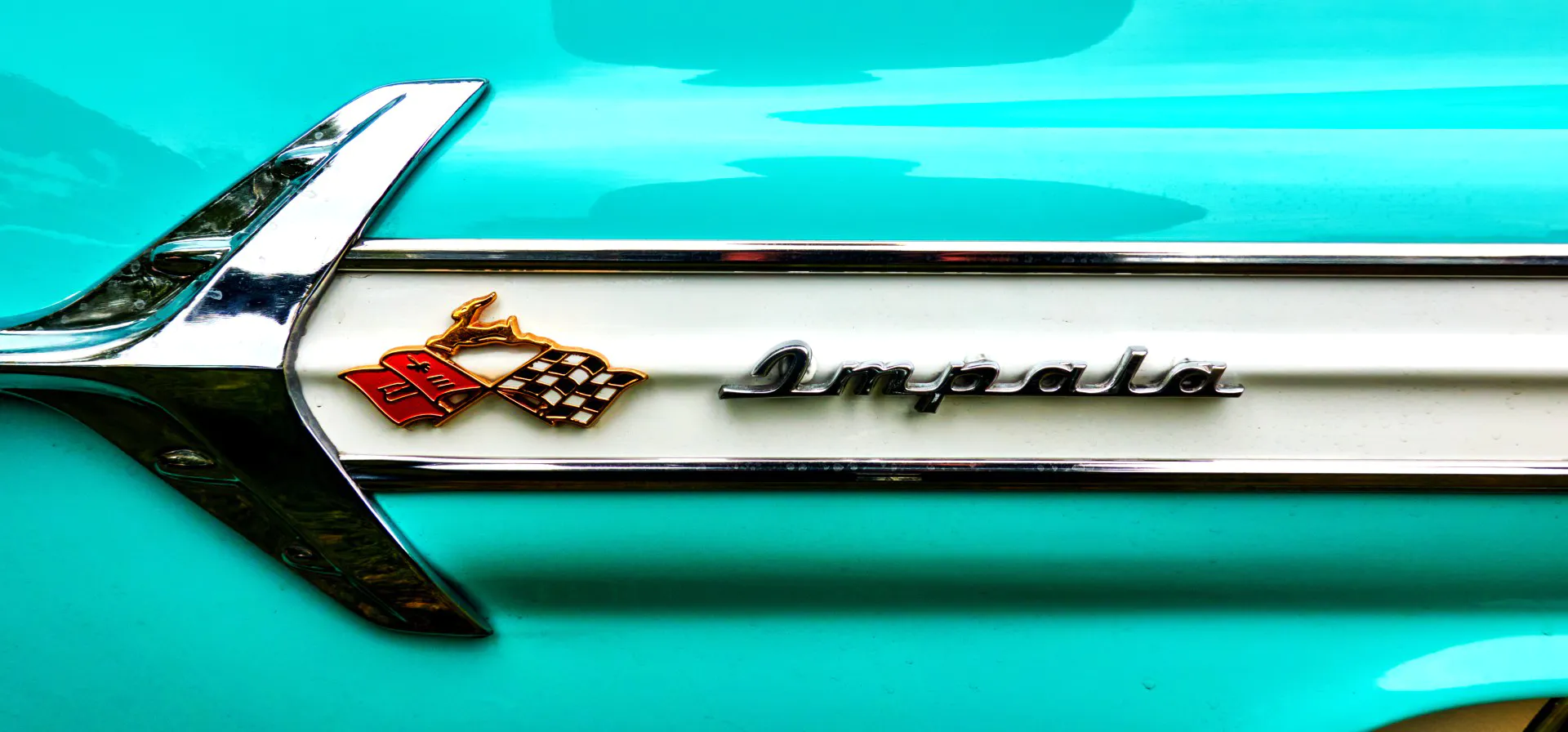
Regrettably, among modern Chevy Impalas, there are more bad years than good ones. These examples are awash in low FIXD Reliability and Owner Reliability Scores, high repair bills, and other undesirable characteristics. Don’t take offense if you already own one of these Impalas; we’re just reporting the facts!
2014 Chevrolet Impala
FIXD Reliability Score: 6/10
Owner Reliability Score: 8/10
KBB Value: $8,859
Fuel Economy: 23 MPG
Average Annual Maintenance/Repair: $789
Average Likelihood of a $500+ Repair in 2022: 80%
Safety Rating: 4.4/5
If you’ve read some of FIXD’s other best and worst year reviews, like the Chevrolet Tahoe and Chevrolet Cruze, you’ll know that we recommend staying away from the first year of an all-new car. And that holds true with the 2014 Chevy Impala, the debut year of the tenth generation.
A FIXD Reliability Score of 6 and an Owner Reliability Score of 8 might typically indicate that this car is a worthwhile consideration. Yet, a deep dive into the data shows otherwise.
To begin with, the 2014 model year is subject to 14 recalls, making it the most-recalled Chevy Impala of the 21st century. Meanwhile, 16% of surveyed owners reported spending at least $500 in 2022 to repair the engine. That’s a significantly higher rate than most other tenth-generation model years.
The surveys reveal some other eye-opening opinions about the 2014 Impala. Only 5% of owners felt their Chevy was cheap to repair. In fact, 53% dislike their Impalas for being expensive to fix.
Like the other Impalas, the 2014 model year has an extensive history of trouble codes. Codes we’ve already covered, like P0420 (a faulty oxygen sensor) and P0171 (a bad MAF sensor), are no strangers to the 2014 Impala. But codes U0100 and U0101 (issues communicating with the engine and powertrain control modules) can arise. Fortunately, these aren’t usually catastrophic error messages. You will likely need to replace a dead car battery at $115 to $496.
From our point of view, you can bypass the risk associated with the 2014 Impala by spending a little bit more to purchase a 2015 or newer model year.
2006-2008, 2011 Chevrolet Impala
FIXD Reliability Score: 4-5/10
Owner Reliability Score: 6-8/10
KBB Value: $3,012-$6,028
Fuel Economy: 20-22 MPG
Average Annual Maintenance/Repair: $795-$909
Average Likelihood of a $500+ Repair in 2022: 75%-82%
Safety Rating: 4.0-4.7/5
The 2006 model year marked a transformative time for the Impala nameplate as Chevy moved from rear-wheel drive to front-wheel-drive for its largest sedan. This time marks the launch of the ninth-generation Impala.
Our advice about avoiding the first year of an all-new model applies here, too. And the data and surveys show you’re best to steer clear of the 2007-2008 Impalas as well. Curiously, the 2011 model year, which sits in the middle of Impala editions we previously recommended (2009-2010, 2012-2013), is also a car to take a pass on.
The 2006-2008 and 2011 Impalas receive mediocre FIXD Reliability Scores (4-5) and mid-grade or better Owner Reliability Scores (6-8). These cars also do well in government crash tests, receiving at least a 4.0 (with a 4.7 rating, the 2006-2008 model years are actually the best-performing Impalas in NHTSA assessments.
Fuel economy, at 20-22 MPG, also makes these Chevy Impalas reasonably efficient. Recalls are modest, as recalls go. The 2006 and 2007 Impala had three recalls each, while recalls dropped to two for each of the 2008 and 2011 model years.
But none of this matters because owners reported an elevated number of expensive engine and transmission repairs. This is THE reason for classifying these Impalas among the worst you can buy.
Among this group, 17% of owners revealed they spent $500 or more to keep the engines running in their Impalas. That’s about one in six owners, not an encouraging number. Meanwhile, about 14% of those with a 2006 Impala and 16% of 2011 Impala owners shelled out similar money to fix the transmission.
We’ll also add further evidence by noting that every one of these model years has above-average annual upkeep expenses. In particular, the 2011 and 2007 Impala owners paid $909 and $865, respectively, to keep their cars on the road.
FIXD sensor data also uncovered a history of numerous error codes in the 2006-2008 and 2011 Impalas. Codes we’ve already mentioned, P0128 (engine coolant thermostat) and P0455 (an EVAP system leak), are common occurrences.
Another EVAP-related issue, code P0449 (EVAP vent circuit control malfunction), is a frequent encounter with owners of these Impalas. This issue requires the typical repairs: a tightened or replacement gas cap or a new EVAP line or control valve.
It’s worth mentioning that the FIXD sensor shows thousands of incidents of codes P0327 and P0010 with the 2011 Impala. What’s startling here is the sheer volume of these codes. Generally, common code incidents number in the hundreds across several model years, but seeing four figures of code occurrences for a single model year is jaw-dropping.
Code P0327 isn’t the worst thing that can happen. It signals a bad knock sensor, which costs $100 to $155. However, P0010 is another matter. This error message indicates a problem with the camshaft and variable valve timing (VVT), a moderately severe issue that needs immediate attention.
In a best-case scenario, a new camshaft position sensor ($120-$300) or crankshaft position sensor ($190-$250) will fix things. However, a replacement VVT control solenoid runs up to $400. If the trouble is traced to wiring, expect to pay $100-$1,000 for repairs. Ultimately, fixing code P0010 could require a new timing belt or chain ($200-$1,000).
2001-2005 Chevrolet Impala
FIXD Reliability Score: 1-3/10
Owner Reliability Score: 4-8/10
KBB Value: $1,901-$2,586
Fuel Economy: 21 MPG
Average Annual Maintenance/Repair: $450-$1,125
Average Likelihood of a $500+ Repair in 2022: 67%-100%
Safety Rating: 4.4/5
Four words summarize our thoughts on the 2001-2005 Impala: just don’t do it. Ordinarily, we look for at least one model year among an older generation that might make for a passable and cheap used car—no such luck with these Chevy Impalas.
Very low FIXD Reliability Scores (2001-2003 Impalas get a 1 out of 10) serve as initial warnings. Owner Reliability Scores are usually more generous, yet a low ranking of 4 (out of 10) for the 2002 Impala and 5 for the 2003 edition confirm our doubts.
But the bad news doesn’t end here.
Ten recalls for the 2001 Impala make it the second-highest recalled model year among all modern Impalas. It gets somewhat better with new versions, as the 2002 and 2004 editions have seven recalls each. Yet, the 2003 Impala is hit with eight recalls. At least it quiets down to four recalls for the 2005 model year.
This is also a good time to point out that with average annual repair and maintenance bills of $1,025 and $925, the 2001 and 2004 Impalas (respectively) are the most expensive model years to keep on the road. The outlay for these cars far exceeds the average $771 that all surveyed owners spent in 2022.
Yet it gets worse. Expensive engine repairs are problematic for this group of Impalas. Excluding the 2002 model year, one out of five owners of these Impalas spent at least $500 on engine repairs last year. Those aren’t great odds. Plus, the cost of this work represents a significant chunk of the value of these cars. Another unfortunate factor.
As the FIXD Reliability Score reveals, check engine lights are ongoing with 2001-2005 Impalas. There are hundreds of recorded incidents involving P0171 (faulty MAF sensor), P0128 (malfunctioning engine coolant thermostat), and P0420 (a bad oxygen sensor).
Meanwhile, other error messages have a strong presence in these Chevys. Code P0171 warns of an incorrect air-to-fuel ratio. Fixes may be simple, like repairing a vacuum or exhaust leak or cleaning the MAF sensor. More involved corrections could require replacing a MAF sensor ($300) or the fuel pressure regulator ($200-$400). A new fuel pump costs $1,300 to $1,700.
Like other Impalas, the 2001-2005 model years have their share of EVAP system-related troubles. This often involves P0446 (EVAP vent control circuit malfunction) with similar repair requirements (a new gas cap, replacing the EVAP line, or installing a new control valve).
FAQs
What years of the Chevrolet Impala have engine and/or transmission problems?
Chevy Impalas from the 2001, 2003-2008, and 2014 model years are most vulnerable to expensive engine repairs. The 2014 Impala has a high likelihood of needy pricing transmission work.
What is considered high mileage for a Chevy Impala?
With a few of the Chevy Impalas in our survey being 20 years old or more, high mileage examples are to be expected. Interestingly, 40% of the surveyed vehicles have at least 150,000 miles on the odometer. Narrowing this down further, 13% have 200,000 or more miles. So, despite there being more bad years than good ones for the Impala, these Chevys are capable of racking up the miles.
Let’s see how this breaks down by generation.
| Chevy Impala Generation | Years | Average Mileage |
| Eighth | 2001-2005* | 154,778 |
| Ninth | 2006-2013 | 148,185 |
| Tenth | 2014-2019^ | 101,834 |
^ 2020 is the last production year for the Chevrolet Impala.
Some individual model years have even higher averages based on survey data. For example, the 2006 Impala has the highest use with 168,750 miles, while the 2008 model year gets close with 166,667 miles. So despite these examples being among the worst Impala years, they can still keep going (often thanks to expensive repairs).
As a group, the 2001-2019 Impalas have an average of 134,392 miles. Given this information and that so many Impalas in our survey have achieved the 150,000-mile threshold (or better), it’s reasonable to assign the high-mileage plateau at 135,000 miles. This detail should be helpful for a used car search.
Getting to this point requires a combination of thoughtful driving, rigorous maintenance, and an accident-free history. A well-maintained Impala with 150,000 miles is likely to offer more years of service than a misused model with 100,000 miles. And the amount of highway versus city driving matters, too.
Ultimately, the best way to determine if a Chevy Impala under consideration is a candidate for the driveway or the junkyard is through a pre-purchase inspection conducted by a professional mechanic.
If you want to buy a Chevy Impala and drive it to at least 150,000 miles on the odometer, look for a 2015-2019 example. If your needs are more short-term, a lower mileage Impala from 2009-2010 or 2012-2013 should do the trick.
What other vehicles should I consider?
You’ll have to go smaller if you want a Chevy sedan other than the Impala. The mid size Chevrolet Malibu is one alternative and, interestingly, is the only Chevy sedan still in production. For an even smaller four-door, the compact Cruze wears the Bowtie emblem (it’s a Chevy too).
Outside of the Chevrolet brand, the Buick LaCrosse and Cadillac XTS (both out of production) share many components with the tenth-generation Impala. Other large sedans include the Toyota Avalon (replaced by the Toyota Crown), Ford Taurus, Chrysler 300, and Dodge Charger.
What owners of the Chevy Impala like to use their car for:
| Frequent Use Categories: | How Useful? (Out of 5 Stars) |
| Family Vehicle | ***** |
| Lots of Driving (travel/long commute) | **** |
| Luxurious Driving | * |
| Office on Wheels | * |
| Hauling/Towing | * |
| Sport/Fast Driving | * |
| Outdoor/Off-Road | * |
A Note About Data and Information Sources
This article has many details about Chevrolet Impala reliability; here’s what we used for our assumptions and recommendations.
- FIXD Reliability Score & Data: Engine reliability information is captured via the FIXD App.
The FIXD Reliability Score is calculated using the number of DTCs per year, weighted by mileage. This is then turned into a scale of 1-10 for easy graphing.
This is an objective score.
- Owner Reliability Score & Data: This data results from surveying Chevrolet Impala owners who use FIXD.
The Owner Reliability Score comes straight from the owners of the Chevrolet Impala.
This is a subjective score.
To determine the Owner Reliability Score, we ask each car owner:
How reliable would you say your Chevrolet Impala is?
a. Just point A to point B driving
b. A Daily Commuter
c. Good for a 100-mile road trip
d. Good for a 500-mile road trip
e. I could take a cross-country road trip, no problem
From here, we translate their answers into the Owner Reliability Score:
a. = 2
b. = 4
c. = 6
d. = 8
e. = 10
Keep in mind owners may think their car is more or less reliable than it actually is.
One potential problem is that people often buy the same make or model they are used to when they go car shopping, just a newer year.
Ford, for instance, has a number of consumer loyalty awards for the Ford F-Series and Ford Expedition.
Car owners may be so loyal to the make or model they currently own that they would have trouble accurately comparing their cars’ reliability to others.
It’s for this reason that we ask car owners a question that is relative to mileage rather than relative to other cars.
Still, be mindful of the accuracy of these Owner Reliability Scores; people’s perceptions and unconscious blindspots can skew data.
We suggest looking at both the FIXD Reliability Score and the Owner Reliability Score for this reason.
- KBB Value: Average private-seller valuations as supplied by Kelley Blue Book (KBB), based on a Chevrolet Impala with typical mileage for that respective model year.
- Fuel Economy: Mileage-per-gallon estimates according to the EPA MPG on Fueleconomy.gov
- Annual Maintenance/Repair: Upkeep expenses as reported by surveyed Chevrolet Impala owners
- Safety Rating: Crash test data collected and reported by NHTSA. We average all ratings for each year to come up with a simplified, average safety score. This makes it easier to look at on a graph.
References
- Chevrolet Impala model-specific information, edmunds.com (various dates). Retrieved May 25, 2023, from https://www.edmunds.com/
- Model-specific recall information as per the National Highway Transportation Safety Administration. Retrieved May 25, 2023, from https://www.nhtsa.gov/recalls
- Chevrolet Certified Used Vehicles information. Retrieved May 28, 2023, from https://www.chevrolet.com/certified-used-vehicles
- 1965-66 Chevrolet Impala, Hemmings (August 23, 2018). Retrieved May 28, 2023, from https://www.hemmings.com/stories/article/1965-66-chevrolet-impala

Dave Goldberg is an automotive journalist and lifelong car fanatic. He writes for numerous enthusiast and business outlets and is an ongoing contributor to HotCars.com, one of the most popular car culture websites. When he’s not writing or driving, Dave is either under a hood or asleep. His credentials include a BA in Journalism from The George Washington University.

